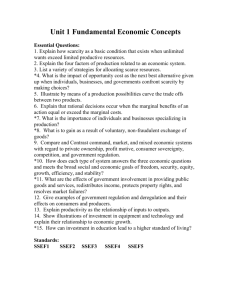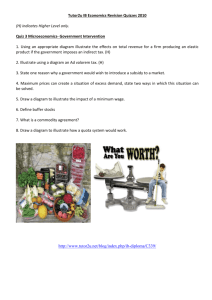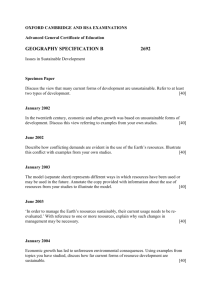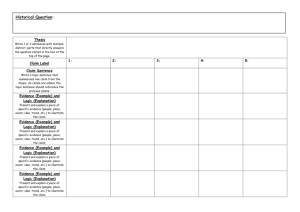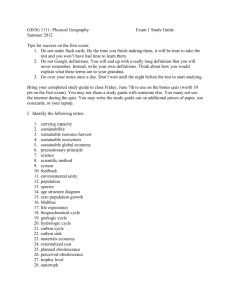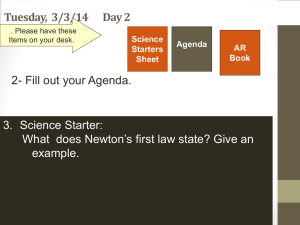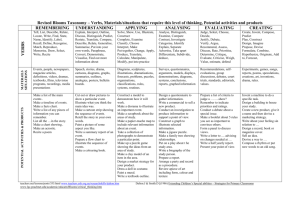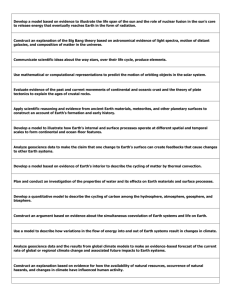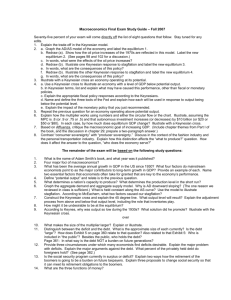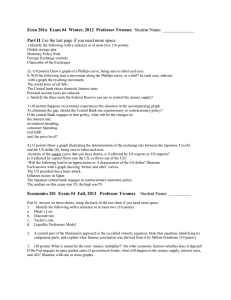Econ-102-Final-Q
advertisement
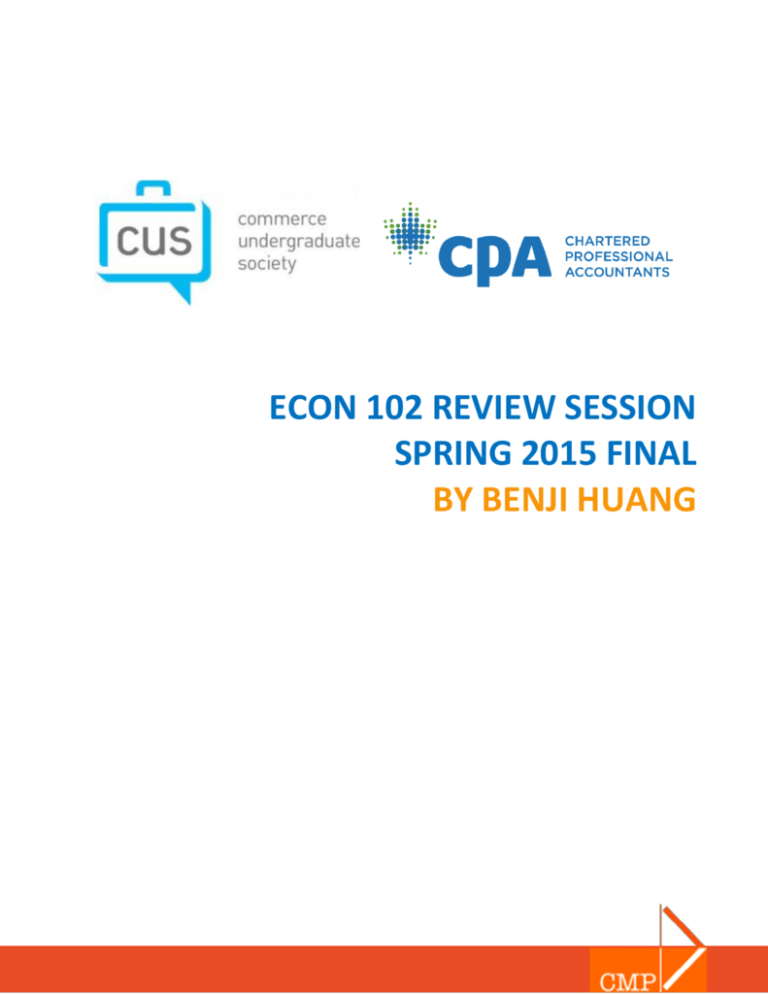
ECON 102 REVIEW SESSION SPRING 2015 FINAL BY BENJI HUANG DON’T YOU’LL ASSUME FAIL HOW TO PASS GATEMAN’S EXAMS: Assume nothing! If you have to assume, state your assumptions clearly. WHEN YOU READ THE QUESTION: Don’t panic. Take a deep breath. Start by defining the question. WHEN YOU ARE STUCK: Move on! The test is long. Prioritize strengths. HOW WOULD I KNOW? I got 100% in his course last year :) Did I get perfect on every single question? No. Did I do better than most other people? You bet. TABLE OF CONTENTS Part 1 – Terms Part 2 – Chapter 30/31 Part 3 – Chapter 33 Part 4 – Chapter 34 Part 5 – Chapter 35 PART 1 – TERMS (BOLDED WORDS IN THE GBOOK/TEXTBOOK) Know them ALL. Here are a few to practise: Rational expectations: Acceleration hypothesis: Dumping: Efficiency wage: NAIRU: Absolute advantage: Learning by doing: Exchange rate : Purchasing power parity: Managed float: * the above definitions are adapted from from Macroeconomics, Thirteenth Canadian Edition by Ragan and Lipsey PART 2 – CHAPTER 30/31 1) What causes a change in money wages? Explain how the component causes interact to create in a change. 2) How does the way people form their expectations about future inflation affect the speed of recovering from a recessionary gap caused by a contractionary monetary policy? 3) Illustrate what condition(s) must be met in order to achieve constant inflation with a diagram. 4) Many people fear deflation because recessions have traditionally been associated with deflation. Is this fear justified? Why or why not. 5) If a government is keen on keeping Y above Y*, is this feasible in the short term? If so, how? What are dangers of such an attempt in the longer term. 6) “Sustained inflation is everywhere and always a monetary phenomenon.” Evaluate this statement. 7) Population and unemployment rate over the last three years have remained constant. However employment rate has decreased by 5%. Use the gross flow of employment to illustrate what might have happened. 8) Differentiate between the new classical theory and the new Keynesian theory in how the two theories address unemployment in the labour market. 9) What are some of the causes that the new Keynesian theory puts forth to explain why wages do not adjust instantly? 10) It is predicted that in 10 years, the percentage of youth or women in the work force will increase tremendously. How will this shift in the composition of the work force affect NAIRU? 11) How can a government reduce unemployment? PART 3 – CHAPTER 33 1) Explain the gains from trade assuming there are only two countries in the world: country A and country B. Assuming trade is possible between the two countries. The only two types of commodities are M and N. Country A has a comparative advantage in M. Use a diagram to illustrate country A’s production possibility boundaries (using a solid line) as well as its trade line (using a broken line). M N 2) How is it possible that with a greater volume of trade, a country’s comparative advantage in producing a commodity might further increase over time. 3) Is it possible for a government to alter a country’s comparative advantage? If so, how? 4) Why is a concave production possibilities boundary more realistic than a straight one? Given the context of a concave production possibilities boundary, how does a change in international relative prices change the optimal bundle of commodities a country should produce. Illustrate with a diagram. A B PART 4 – CHAPTER 34 1) How and when is it possible for a country to improve the terms of trade through protection? 2) Maximizing national income is not always the political priority of a government. What are some reasons to engage in trade protectionism that don’t involve maximizing national income? 3) Why is the argument that protection creates domestic jobs (leading to an improved economy) unjustified? 4) Explain why tariffs are more preferable for the importing country than quotas using a diagram. P Q 5) What is countervailing duties and how can they be abused as a method of protection? 6) how does trade diversion reduce the benefits that an importing country can gain from trade? PART 5 – CHAPTER 35 1) If a country has a current account surplus, what can you conclude about the said country’s capital account? Why? Explain as if you are explaining to someone who has no econ knowledge. Now in addition you know that the net change in investment abroad is less than the net change in foreign investment in the said country. What can you conclude about the Official Financing Account? What can you conclude about the Official Reserve? 2) Given that the central bank doesn’t intervene in the foreign exchange market, how will a relative increase in the domestic price of aluminum (a major export of a country) affect the said country’s exchange rate? 3) How can the central bank influence the exchange rate using monetary policy? 4) A country’s central bank believes that the market determined value of the domestic currency is usually “correct” in the long run. However from time to time the central bank wishes to stabilize the short run fluctuations. What type of system will the central bank use to achieve this goal. 5) Define mercantilism and explain why the concept of mercantilism no longer applies today in analysing the foreign exchange market. 6) What is the equation that can help to determine the current account balance. Use the equation to illustrate what happens to the current account balance when the government reduces taxation. 7) Using the purchasing power parity concept explain how inflation can lead to an increase in exchange rate. 8) In an attempt to encourage export (a current account surplus), a country can choose to fix exchange rates above that of the natural market equilibrium. How can this be done? Illustrate with a diagram. What might be a danger of pegging the exchange rate? ___________________________________________________________________________________ DISCLAIMERS: The above questions are only meant to help you solidify your Econ 102 understanding and to help you get a feel for the level of difficulty that you might be reasonably expected to encounter on an actual Gateman exam. However the real exam might take any format and might include: T/F, multiple choice, short answers, calculations, problems, articles, etc. Most of the questions above are designed by the author based on his past experience with Gateman’s exams, with the notable exception of starred (*) questions which are taken with permission from professor Alfred Kong’s Econ 102 sample exam. Starred questions are included by the author based on the judgement that they are reasonably similar to the types of question that Gateman has asked before. As always, knowledge comes first. Exam-taking finesse comes second.
